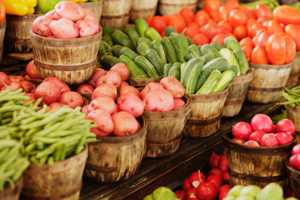Vitamins: Their Functions and Sources
Topic Overview

The tables below list the vitamins, what they do in the body (their functions), and their sources in food.
Water-soluble vitamins
Water-soluble vitamins travel freely through the body, and excess amounts usually are excreted by the kidneys. The body needs water-soluble vitamins in frequent, small doses. These vitamins are not as likely as fat-soluble vitamins to reach toxic levels. But niacin, vitamin B6, folate, choline, and vitamin C have upper consumption limits. Vitamin B6 at high levels over a long period of time has been shown to cause irreversible nerve damage.
A balanced diet usually provides enough of these vitamins. People older than 50 and some vegetarians may need to use supplements to get enough B12.
|
Nutrient |
Function |
Sources |
|---|---|---|
|
Thiamine (vitamin B1) |
Part of an enzyme needed for energy metabolism; important to nerve function |
Found in all nutritious foods in moderate amounts: pork, whole-grain or enriched breads and cereals, legumes, nuts and seeds |
|
Riboflavin (vitamin B2) |
Part of an enzyme needed for energy metabolism; important for normal vision and skin health |
Milk and milk products; leafy green vegetables; whole-grain, enriched breads and cereals |
|
Niacin (vitamin B3) |
Part of an enzyme needed for energy metabolism; important for nervous system, digestive system, and skin health |
Meat, poultry, fish, whole-grain or enriched breads and cereals, vegetables (especially mushrooms, asparagus, and leafy green vegetables), peanut butter |
|
Pantothenic acid |
Part of an enzyme needed for energy metabolism |
Widespread in foods |
|
Biotin |
Part of an enzyme needed for energy metabolism |
Widespread in foods; also produced in intestinal tract by bacteria |
|
Pyridoxine (vitamin B6) |
Part of an enzyme needed for protein metabolism; helps make red blood cells |
Meat, fish, poultry, vegetables, fruits |
|
Part of an enzyme needed for making DNA and new cells, especially red blood cells |
Leafy green vegetables and legumes, seeds, orange juice, and liver; now added to most refined grains |
|
|
Cobalamin (vitamin B12) |
Part of an enzyme needed for making new cells; important to nerve function |
Meat, poultry, fish, seafood, eggs, milk and milk products; not found in plant foods |
|
Ascorbic acid (vitamin C) |
Antioxidant; part of an enzyme needed for protein metabolism; important for immune system health; aids in iron absorption |
Found only in fruits and vegetables, especially citrus fruits, vegetables in the cabbage family, cantaloupe, strawberries, peppers, tomatoes, potatoes, lettuce, papayas, mangoes, kiwifruit |
Fat-soluble vitamins
Fat-soluble vitamins are stored in the body’s cells and are not excreted as easily as water-soluble vitamins. They do not need to be consumed as often as water-soluble vitamins, although adequate amounts are needed. If you take too much of a fat-soluble vitamin, it could become toxic. Your body is especially sensitive to too much vitamin A from animal sources (retinol) and too much vitamin D. A balanced diet usually provides enough fat-soluble vitamins.
|
Nutrient |
Function |
Sources |
|---|---|---|
|
Vitamin A (and its precursor*, beta-carotene) *A precursor is converted by the body to the vitamin. |
Needed for vision, healthy skin and mucous membranes, bone and tooth growth, immune system health |
Vitamin A from animal sources (retinol): fortified milk, cheese, cream, butter, fortified margarine, eggs, liver Beta-carotene (from plant sources): Leafy, dark green vegetables; dark orange fruits (apricots, cantaloupe) and vegetables (carrots, winter squash, sweet potatoes, pumpkin) |
|
Vitamin D |
Needed for proper absorption of calcium; stored in bones |
Egg yolks, liver, fatty fish, fortified milk, fortified margarine. When exposed to sunlight, the skin can make vitamin D. |
|
Vitamin E |
Antioxidant; protects cell walls |
Polyunsaturated plant oils (soybean, corn, cottonseed, safflower); leafy green vegetables; wheat germ; whole-grain products; liver; egg yolks; nuts and seeds |
|
Vitamin K |
Needed for proper blood clotting |
Leafy green vegetables such as kale, collard greens, and spinach; green vegetables such as broccoli, brussels sprouts, and asparagus; also produced in intestinal tract by bacteria |
Current as of: November 7, 2018
Author: Healthwise Staff
Medical Review:Kathleen Romito, MD – Family Medicine & E. Gregory Thompson, MD – Internal Medicine & Rhonda O’Brien, MS, RD, CDE – Certified Diabetes Educator
Topic Contents
This information does not replace the advice of a doctor. Healthwise, Incorporated, disclaims any warranty or liability for your use of this information. Your use of this information means that you agree to the Terms of Use. Learn how we develop our content.

